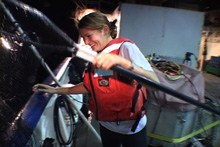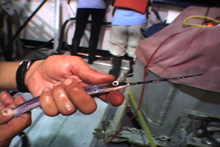
Jennie McClain immediately after the halfbeak she caught slipped through the net mesh and back into the water. Click image for larger view and image credit.
Nightlight Delight
October 21, 2005
Bob Schwartz
Web Coordinator
NOAA Public Affairs
I just had the pleasure of joining the night crew, Tara Casazza, Jennie McClain, Barb Lubinski and Reneé Green; as they conducted their first night lighting session of this cruise. After the afternoon dive returned early this evening, the Seward Johnson began a 5-hour steam south to a site off Cape Fear, which Dr. Ross chose for this operation.
Around 1:00AM we arrived onsite, and I joined the team, camera in hand, hoping to capture some video of the action.
Dr. Ross explains the purpose and use of nightlighting: “One goal of this team is to keep sampling all habitats all the time we are out here. Nightlighting is one of our tools for collecting surface animals that are otherwise difficult to sample. Many fishes and invertebrates are phototrophic (attracted to lights). One of our target groups for sampling with this method are the flyingfishes and squids. These fast-moving surface oriented animals (especially the flyingfishes) are very hard to obtain with more conventional methods; therefore, we know less about them. The types of data the team has collected using nightlighting include the diversity and relative abundance of flyingfishes, squids, halfbeaks and others in this region, some data on feeding habits, spawning and environmental conditions associated with different species,” he said.
Basically, the operations of nightlighting involve shining bright lights into the water, which attract phototrophic fish. The team attached a 1000-watt light, similar to those used in television studios, to a pole; secured it, and aimed it into the water just off the port stern. Another similar light was rigged up on starboard side. The team then watched the lighted area, with 12-foot-long dip nets in hand, in hopes of catching some specimens of flyingfish (or whatever they could get.)
I was there to capture it on video and, since we were working over the side of the ship in medium seas and I was trying to get angles of the team’s faces, I became concerned about the very real possibility of losing my camera. I’ve taken this camera through swamps, up high scaffolds and crow’s nests, underwater and even through a hurricane. If I’m going to lose the camera, it’s not going to be because I butterfingered and dropped it into the ocean. So, I left my post to search for some rope to secure the camera to myself.
I was gone all of two minutes and when I returned, Tara was holding a long, thin fish she caught in my absence. She quickly identified it as a Hemiramphus balao, commonly known as a halfbeak. About 10-inches long, with darkish-blue coloring above, silvery white below and a greatly prolonged beak-like lower jaw, the halfbeak is very common in these waters. Tara stored the specimen and the rest of us went about fishing for more.
Several flyingfishes were visible in the lighted area on the port side, but they proved too deep to catch, even with the long-poled dip nets. Around 3:00AM, time began to slow down as we watched the roiling seas, and I began to wonder if I’d be able to wake up to shoot the morning submersible deployment. Then we saw it.
Another fish, looking very similar to the halfbeak Tara caught, was crisscrossing the outskirts of the lighted area near the hull of the ship. I rolled camera. After a few tries, Jennie netted the fish. Both of us were elated, Jennie for catching her first fish of the night and I for catching video of Jennie catching the fish. She pulled the net in, reached for the fish, it dropped through the large mesh of the net, hit the deck, and slipped back into the ocean. I’ve included a frame-grab of Jennie’s face just after it happened. That will explain her reaction much better than I can put into words. No sampling method is 100% efficient.
The larger-mesh net would have been adequate for catching the larger species of flyingfish that are usually common in this area. But unfortunately for Jennie (and fortunately for her fish), the larger the mesh in the net, the less likelihood of catching smaller fish. After a few moments of reflection and laughter, Jennie switched nets with Tara, whose net had much smaller mesh, and we went fishing again.
After around twenty minutes of watching a lot of nothing happening in the water, I decided to leave the port side again and roll some footage of Barb Lubinski who was busy patrolling the starboard side. Barb reported she had seen several fish but was unable to catch any. After a few minutes, we heard the unmistakable voice of Jennie McClain shouting “I caught a fish!” We turned to see a triumphant Jennie, arms in the air, dancing a highland fling that would have impressed Murray Roberts. Okay, she wasn’t dancing, but she was pretty happy. We went over to inspect the fish and, sure enough, it was another halfbeak of the same species as the first, and about the same size.
In Jennie’s words, “I caught two fish but only landed one, but either way it was a productive night.” If we try night lighting again, I’ll join them again with the camera and just walk away every time they want to catch a fish. That seems to do the trick.
Life on the Edge will be sending daily reports from Oct 16 - Nov 4. Please check back frequently for additional logs from this expedition.


























